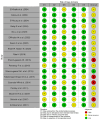Recovery Time, Patient Satisfaction, and Safety of Intranasal Sedatives in Pediatric Dentistry: A Systematic Review and Meta-Analysis
- PMID: 40565785
- PMCID: PMC12194465
- DOI: 10.3390/jcm14124038
Recovery Time, Patient Satisfaction, and Safety of Intranasal Sedatives in Pediatric Dentistry: A Systematic Review and Meta-Analysis
Abstract
Background: Intranasal sedation is commonly used in pediatric dentistry to manage dental anxiety and improve patient compliance. This systematic review and meta-analysis aimed to evaluate the recovery time, patient satisfaction, and adverse effects of the intranasal sedatives midazolam, dexmedetomidine, and ketamine in pediatric dental procedures. Methods: A systematic search of PubMed, Scopus, the Web of Science, the Cochrane Library, Embase, and Google Scholar was conducted following the PRISMA 2020 guidelines. Only randomized controlled trials (RCTs) involving intranasal sedation in pediatric patients (≤18 years) were included. The revised Cochrane risk of bias tool (RoB 2) was employed to assess study quality. A meta-analysis using a random-effects model was performed to evaluate the recovery time. Results: Twenty-one RCTs were included in this review. A meta-analysis of seven studies revealed that dexmedetomidine was associated with significantly longer recovery times compared to midazolam and ketamine. Specifically, midazolam demonstrated the shortest recovery time (mean difference: -19.1 min, p < 0.05), followed by ketamine (mean difference: -15.6 min, p < 0.05). A qualitative analysis of adverse effects showed mild to moderate complications, including nasal irritation (midazolam), prolonged sedation (dexmedetomidine), and hypersalivation (ketamine). Patient satisfaction was found to be highest with dexmedetomidine, although midazolam was preferred for its faster onset of sedation. Conclusions: Intranasal sedation in pediatric dentistry is a safe and effective approach, with each agent exhibiting distinct recovery profiles and safety considerations. The findings emphasize the importance of standardized sedation protocols and the need for further research into the long-term outcomes of these sedatives in pediatric populations.
Keywords: adverse effects; dexmedetomidine; intranasal sedation; ketamine; meta-analysis; midazolam; patient satisfaction; pediatric patients; recovery time; systematic review.
Conflict of interest statement
The authors declare no conflicts of interest.
Figures




Similar articles
-
Chloral hydrate as a sedating agent for neurodiagnostic procedures in children.Cochrane Database Syst Rev. 2021 Aug 16;8(8):CD011786. doi: 10.1002/14651858.CD011786.pub3. Cochrane Database Syst Rev. 2021. PMID: 34397100 Free PMC article.
-
Chloral hydrate as a sedating agent for neurodiagnostic procedures in children.Cochrane Database Syst Rev. 2017 Nov 3;11(11):CD011786. doi: 10.1002/14651858.CD011786.pub2. Cochrane Database Syst Rev. 2017. Update in: Cochrane Database Syst Rev. 2021 Aug 16;8:CD011786. doi: 10.1002/14651858.CD011786.pub3. PMID: 29099542 Free PMC article. Updated.
-
Efficacy and safety of intranasal ketamine compared with intranasal dexmedetomidine as a premedication before general anesthesia in pediatric patients: a systematic review and meta-analysis of randomized controlled trials.Can J Anaesth. 2022 Nov;69(11):1405-1418. doi: 10.1007/s12630-022-02305-1. Epub 2022 Aug 16. Can J Anaesth. 2022. PMID: 35970989 English.
-
Effectiveness of preoperative intranasal dexmedetomidine, compared with oral midazolam, for the prevention of emergence delirium in the pediatric patient undergoing general anesthesia: a systematic review.JBI Database System Rev Implement Rep. 2017 Jul;15(7):1934-1951. doi: 10.11124/JBISRIR-2016-003096. JBI Database System Rev Implement Rep. 2017. PMID: 28708753
-
Midazolam for sedation before procedures.Cochrane Database Syst Rev. 2016 May 20;2016(5):CD009491. doi: 10.1002/14651858.CD009491.pub2. Cochrane Database Syst Rev. 2016. PMID: 27198122 Free PMC article.
References
-
- Chhibber A.K., Fickling K., Lustik S.J. Pre-anesthetic Midazolam: A Randomized Trial with Three Different Routes of Administration. J. Anesth. Clin. Res. 2011;2:118. doi: 10.4172/2155-6148.1000118. - DOI
-
- Eric J., Davidovic B., Mladenovic R., Milosavljevic M., Miljevic I.D., Bjelovic L., Jankovic S., Dolic O., Davidovic B. Prevalence of Dental Fear and Its Association with Oral Health Status Among School Children in Bosnia and Herzegovina: A Cross-Sectional Study. Medicina. 2025;61:55. doi: 10.3390/medicina61010055. - DOI - PMC - PubMed
-
- American Academy of Pediatrics. American Academy of Pediatric Dentistry. Coté C.J., Wilson S., Work Group on Sedation Guidelines for monitoring and management of pediatric patients during and after sedation for diagnostic and therapeutic procedures: An update. Pediatrics. 2006;118:2587–2602. doi: 10.1542/peds.2006-2780. - DOI - PubMed
Publication types
Grants and funding
LinkOut - more resources
Full Text Sources

